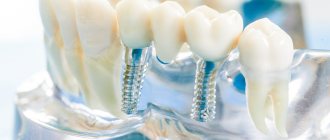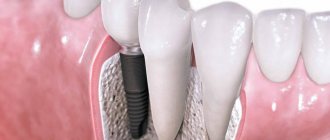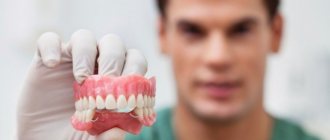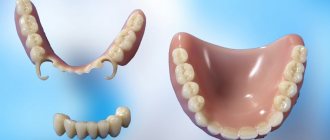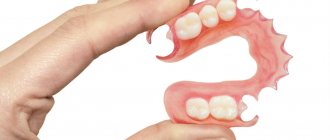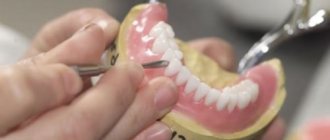Korostelev Egor Dmitrievich
Source:
Clinic “It Doesn’t Hurt!”
Enlarge
When making any removable denture (complete, partial), regardless of the material of the prosthesis (acrylic plastic, acry-free, nylon or clasp denture), the patient goes through the same steps. Usually you have to make 4 visits to the dentist.
Artificial jaws: types
First of all, let's define the terminology to make the following text easier to understand.
- Basis - the base, which looks very similar to the gum, fits tightly to the oral cavity. The borders are made of modern polymer materials.
- Fastening – various locks with hooks securing the entire structure to supporting healthy organs.
- Implants are elements firmly embedded in the base, replacing individual chewing units. In production, light components are used that are as close in color to real teeth as possible.
Classification by type
Types are divided according to the substances contained in the composition. However, a distinction based on how partial dentures are placed, how they are inserted and secured, and what the dentures look like is the most correct approach.
Lamellar
The most inexpensive and accessible way to restore chewing functions. The plastic base completely covers the curves in the patient’s mouth and the contours of the gums. They are attached to supporting intact masticatory organs. Acrylic, nylon, and other modern materials that prevent allergic reactions are used in the production of these implants.
Low cost with simple fixation are the main advantages. The age group of patients for their use is not limited. However, the restoration of chewing functions does not occur completely; diction may be impaired, and the structure does not hold well in the mouth. The photo shows the installation of removable plate and one-sided dentures on hooks.
Clasp
Artificial analogues are attached to a metal frame. Since the base is made of durable material, the product will last quite a long time. Installed using various hooks, crowns and other methods.
This type of substitution is not suitable for those who have allergic reactions to the main component. High cost is also a significant disadvantage. Among the positive features are strength, strong fixation, complete restoration, natural appearance.
Immediates
They cannot be considered a permanent solution, as they are temporary measures. The installation of partially removable dentures is shown in the photo.
For a short period of time they can completely restore all aesthetic and chewing functions. But, it should be remembered that their use is only possible when one or two damaged units are restored.
Low cost along with quick installation are positive aspects. Soft components make the implant unstable to heavy loads and greatly reduce its service life. The use of immediates is common in dental practice when it is necessary to prevent the displacement of remaining teeth towards the removed ones.
Materials for the manufacture of fixed dentures
At this stage, you cannot do without a visit to the dental office, where the orthodontist performs a set of activities:
- A thorough examination of the oral cavity and identification of existing problems;
- Patient visiting the X-ray room. The image will help the specialist determine the condition of the bone tissue and possibly identify gum abnormalities;
- Sanitation of the oral cavity – removal and treatment of remaining teeth, removal of tartar, whitening (at the request of the patient);
- Selection of the shade of the artificial crown, the option of the future prosthesis and material;
- Taking a plaster cast of the jaw, on the basis of which diagnostic and auxiliary prostheses are made;
- Assessment of jaw occlusion and identification of possible deviations using wax rollers;
- Drawing a drawing of the future prosthesis on a diagnostic model;
- Drawing the outline of the frame on the working model, based on the marks of the diagnostic model;
- Contour correction using a parallelometer;
- Trying on the prosthesis and eliminating possible defects;
- Final fitting of the finished product, explanation of the rules of operation and care.
How to make a denture, a completely artificial false jaw: materials
The components that form the basis of such products determine the quality of human life. Good and durable, anti-allergenic, do not cause discomfort, are installed painlessly, quickly and easily. The main thing is that there is no rejection.
Prostheses from the low price segment are often manufactured in a short time. However, they do not tolerate heavy loads well, do not last long, and can cause unpleasant sensations: itching, irritation of the oral cavity.
Plastic
Affordable and widespread chemical material. It is used in all spheres of human life: from domestic needs to medical. It gained popularity due to its efficiency and easy processing.
Low cost greatly influenced its development in dentistry. The affordable price is perhaps its only advantage in this area. Simple installation, fastening of partially removable and fully overlay plate dentures with the palate has the following reviews:
- fall out;
- ugly appearance;
- cause severe discomfort while eating due to unevenly distributed load.
Particularly weak attachment in the lower jaw area. The sublingual space is uneven, so it is impossible to attach a classic suction cup to it. The problem is solved as follows:
- use special creams for retention;
- installation of the lower chewing part is carried out on living units.
Orthopedic products are held in place by clasps, which grip the implant at the base and give the structure the necessary rigidity. The most popular are removable dentures ivocap with the following pros and cons.
Positive traits:
- the upper jaw has good stability;
- low cost;
- common;
- suitable for repair;
- ease of construction;
- unpretentious in care.
Negative sides:
- a large frame takes up a lot of space in the mouth;
- clasps are noticeable with close eye contact;
- the lower part is poorly fixed;
- the alveolar arch and process gradually atrophy;
- short-lived.
Recommended as a temporary solution, or for complete/partial edentia.
Made from acrylic
The most inexpensive and widespread prostheses, which are based on polymer masses of low cost and quality. Among all lamellar ones, they are able to provide acceptable aesthetics. They are highly allergenic, fall out, break and cause discomfort.
Acry-free
Removable dentures or dentures made from an improved polymer relieve its owner from possible irritation of the oral cavity, are more durable, and reduce the risk of breakage.
An excellent option for temporary solutions while a high-quality and durable replacement is manufactured. People with hypersensitivity can easily wear them until full implants are inserted.
Spofadent
The base is made of three-layer plastic. They are characterized by durability, strength, resistance to chemical compounds, and visual appeal.
The design is loved by dentists and clients for its beautiful appearance. A colored complete removable denture is an analogue of living tissue.
IvoBase
Polymethyl methacrylate is an organic plastic that has innovative properties thanks to a unique creation method (the polymer is mixed in an injection device):
- greatly reduces the risk of an allergic reaction;
- prevents hypersensitivity;
- eliminates errors (low bite, large shrinkage).
Automation follows the entire technological process exactly. As a result, porosity decreases and strength increases. These properties ensure the durability of the entire system.
Vertext
Modern and thermoplastic, eliminates the use of monomer. Dryness, burning, allergic reactions are completely absent. The material is much stronger than analogues. Consequently, the basis is very thin. In turn, it increases the sensitivity of taste buds and articulation.
DeFlex
An Argentine company has made a breakthrough in dentistry by developing a polyamide that ensures complete transparency of the entire frame, including clasps. Transmitting light, it completely merges with the tissues of the oral cavity.
Widely used by athletes, police officers, and emergency services to provide jaw protection.
Nylon
The base is filled with soft nylon. 100% transparency ensures complete fusion with the mucous membrane. Clasps are made of the same material.
The patient quickly gets used to the foreign body in the mouth. High elasticity reduces stress on gums and soft tissues. The sufficient strength of the material used makes it possible to minimize the frame in order to maintain diction.
However, the pros turn out to be cons. To answer the described contradiction, it is important to understand the following question: how is a full-fledged nylon denture installed?
The thin and elastic component located at the base requires a mesh structure. When chewing hard food, fibers dig into the palate or gums, causing pain.
Advantages:
- quick addiction;
- 100% camouflage;
- biocompatibility.
Flaws:
- frequent hair loss requires you to always use fixing creams and ointments;
- chewing function – weak;
- expensive;
- lead to accumulation of plaque on the rough part;
- require adherence to a strict diet;
- the alveolar ridge bears the entire load.
Indications for use:
- partial edentia with preservation of supporting organs;
- in cases where aesthetics comes to the fore;
- The patient is allergic to acrylic.
So, we figured out how false jaws are made, the pros and cons of dental prostheses and various components. Let's move on to indications for the use of other types.
Causes and types of prosthesis failures
There are many reasons for failure of artificial structures:
- Dentist mistakes during preparatory work. Incorrectly taken dental impressions lead to the production of an unsuitable denture.
- If the dental technician used a low-quality metal alloy or acrylic plastic (in which air bubbles are visible), the denture will most likely not last long.
- Errors made during laboratory manufacturing. The slightest mistake will lead to incorrect distribution of the chewing load on the teeth or a loose fit of the structure.
- Carelessness in care and wearing. Fall, use of unsuitable solution, poor or irregular hygiene, improper fixation or removal of the structure.
- Physiological changes in the jaw. Over time, changes may occur in the structure of the alveolar processes, which will lead to a loose fit of the base.
- Wear or end of service life. Each material has a certain service life. After its expiration, the quality characteristics of the materials decrease, the prosthesis becomes fragile and unreliable.
Immediate
Replace a unilateral included defect. The design can be created from any materials used in dentistry. Capable of restoring a row of holes. Also found under the name "butterflies".
Several artificial crowns are attached to a miniature base, secured with hooks and locks. Recommended as a temporary solution after removal of diseased masticatory organs.
For those who are going to install metal ceramics and do not have enough money, it helps to gain time to collect them. Some patients use it all their lives, replacing it with a new one after a few years.
What is needed for a quick repair?
The best option is to visit the pharmacy and purchase one of the dental adhesives designed for repairing dentures:
- ROCS is an air-curing plastic with good adhesive properties and high strength after hardening. When carefully applied to the gluing area, no additional sanding is required;
- “Coracryl” is a two-component composite material that hardens in air. The composition is prepared immediately before application to the broken prosthesis;
- “Protacryl”, “Redont” - powder and liquid for its dissolution. The resulting liquid plastic hardens under the influence of moisture contained in the air. Composition for emergency repair of acrylic dentures.
Conditionally removable
Anyone who has ever gone to the dentist for dentures is concerned about how to make them, who makes and inserts dentures on hooks, what methods of fastening exist, and what they look like on the teeth.
The design received its name due to special fixation methods. Special crowns and clasps ensure a secure fit in the mouth. They will never fly out on their own. You can remove it using special skills (usually a dentist does this).
Clasp
This type of implant is described above. Additionally, 3 types of structures should be distinguished:
- Clammers. The metal claw mount provides a secure fit and poor aesthetics.
- Lock. Divided into two parts: the first on the side, the second on the inside. Installation of such a connection requires grinding of adjacent elements.
- Telescopic. The inner crown is made of solid metal, onto which an outer structure (for example, ceramic) is placed.
Indications for use:
- edentia, in which at least 5 teeth are preserved;
- more than three units in a row are missing;
- mobile teeth (loose);
- other implants cannot be installed.
Quadrotti
Clasp or clasp without metal. Biocompatible plastic is at the core of the entire design.
Positive traits:
- there is no need to grind the supporting parts;
- the material does not cause allergies;
- cheap;
- the patient gets used to it easily;
- the chewing load is distributed correctly.
Negative qualities:
- despite greater stability compared to fully removable ones, the fixation is weak;
- the classic arc has high strength;
- service life is 3-4 years.
How a new generation of complete removable dentures are attached without a palate and what they are like
It is based on two materials:
- hard acrylic for bases and implants;
- soft polyurethane for fasteners.
At the base of the mechanism is an imitation of gum, which ensures a strong fixation. Dentists are still arguing about what type they should be: completely removable or not.
Do-it-yourself prosthesis repair at home
The best way to repair a prosthesis is to contact a specialized laboratory technician. He will not only eliminate the defect, but also carry out preventive cleaning and correct the unbalanced basis. But situations arise when a visit to the dentist is simply impossible, so you can repair the structure at home.
The success of the procedure depends on the cause of the breakdown:
- poor quality and dentist errors;
- wear and tear of the material after the end of its service life ;
- abuse of crackers, nuts;
- gum subsidence.
What to choose if you are completely missing teeth
If the doctor has not identified any contraindications, separate implants are recommended. However, you can look towards removable or partially removable options.
Partial absence
Conducive to installing butterflies and crowns. Any of the methods described in the article is suitable for replacing a bite. Only a qualified specialist can provide the correct advice in each specific case.
For the upper and lower parts of the mouth
If we are talking about removable structures, plate options can be used at the top, and fixed ones at the bottom. This advice is based on the anatomical features of the jaw. However, only the doctor will provide the correct solution.
Stock
-27%
Teeth in 1 day on Straumann implants using ProArch technology!
300,000 rub. 220,000 rub.
get -13 %
Promotion for installation of veneers!
40000 rub. 35,000 rub.
get -9 %
BASAL COMPLEX - Restoration of teeth on 1 jaw in 3 days 330,000 rub.
300,000 rub.
get -20 %
Osstem implant + zirconium dioxide crown 100,000 rub.
80,000 rub. get
Service life and care
Durability depends on materials, quality of installation and maintenance. The following tips will help you make it last as long as possible:
- every 6 months it is necessary to visit a doctor to assess the condition - especially when using rigid structures;
- 2 times a day you need to treat the oral cavity and removable jaws with a solution or rinse with clean water;
- follow individual recommendations received from your doctor.
The article answered the questions: what is a complete and partially removable denture, what types are there in dentistry, which are better, what the price depends on. It should be noted that the text is not a guide to action; its main purpose is to introduce the reader to the varieties. If you have any questions or pain, please contact your dentist.
How to quickly get used to removable dentures
Do not despair if removable dentures are installed, and the patient feels discomfort and difficulties when using the new structures.
A mandatory stage in the installation of removable dentures is the correction stage. In this case, the specialist must warn the patient that he must wear his prosthesis for several days and feel it. This is the only way to create the necessary prosthetic bed. Most likely, there will be discomfort.
However, you cannot remove the prosthesis and bring it with you to the dentist: it is by the abrasions in the oral cavity that the specialist will determine how and how much it is necessary to correct this prosthesis.
10 tips for patients
- The process of getting used to dentures is individual for everyone. This may depend on the type of dental structure, the degree of its fit, and the condition of the gums. For example, the adaptation period for clasp structures is the longest, since its metal parts are traumatic for the oral mucosa. And although the average period of getting used to removable structures is about 30 days, with aggravating factors, adaptation can last up to 3 months.
- The psychological mood of the patient is important. In nervous patients who want to remove the prosthesis in case of any inconvenience, the period of adaptation is delayed.
- In the field of prosthetics, you should not switch to ground or liquid foods. It is enough to simply chop the products. It is recommended to avoid foods such as seeds, nuts, dried fruits, toffees, etc.
- Gum massage can help with adaptation. It is enough to do it in the morning and evening for about 10-15 minutes. In this case, the thumb is located inside the gum, and the index finger is located outside, and then the gum is stroked and rubbed. This stimulation of blood circulation will allow the gums to become elastic and make it easier to wear dentures.
- Impaired diction should not frighten patients. In this case, it is enough to introduce exercises on pronouncing words and tongue twisters into your daily schedule. It is also effective to use exercises for the tongue: lifting up and down, rotating inside the mouth clockwise and counterclockwise, retracting the cheeks, etc.
- Daily use of mucosal healing products. To do this, after each meal, you can rinse with herbal decoctions (chamomile, sage, calendula), ready-made pharmaceutical products (Elekasol collection, Rotokan antiseptic, etc.), lubricating the gums with gels (Solcoseryl, Metrogyl denta, Asepta).
- At first, dentists advise leaving the denture on overnight. This will help the mucous membrane get used to it faster and shorten the adaptation time.
- Many patients have to use denture adhesive or special pads. This ensures the necessary fixation of the prosthesis in the mouth, especially in the edentulous lower jaw. These products help prevent chafing and prevent food from getting under the structure.
Do not despair if it is difficult to use the prosthesis at first. The adaptation period is painful for older people who are faced with the need to install complete removable structures for the first time.
If an elderly patient has already used dentures, then adaptation during repeated prosthetics will be easier and faster.
What to do if the prosthesis breaks?
A suddenly broken prosthesis brings a lot of inconvenience. A person asks the most important question: “What to do if the removable structure breaks?”
The clinic will be able to assess the condition of the false jaw and properly repair it. Repairs take from several hours to several days, depending on the extent of the damage. New fastenings or crowns may be needed, the production of which takes a lot of time. Sometimes it is no longer possible to repair it, or the cost of repair is not much different from the cost of the entire prosthesis. In this case, you will have to order a new one.
Contacting specialists
It is best to contact the same specialist who performed the prosthetics. In addition, many clinics provide a guarantee, so if the prosthesis is cracked through no fault of the patient, the repair will be free.
You need to collect all the broken parts and bring them to the dentist. He will assess the damage and the possibility of restoration. After this, the cost of the work and the time to repair will become known. Doctors are very successful in repairing such structures, giving them their original appearance.
The dental laboratory has all the necessary equipment, devices and materials. In addition, the doctor will perform a professional cleaning, removing tartar, pigmentation, plaque and bacteria, and food microparticles.
How to repair at home?
It is possible to bring a denture into working condition with your own hands, but it is not entirely easy to do. It is worth noting that experts have an extremely negative attitude towards repairs at home, since inept manipulation can completely ruin the prosthesis.
Pharmaceutical preparations can firmly fix the fragments. You can use them at home when the prosthesis has broken into two separate parts. There are many training videos posted online that clearly describe the entire process. Ideally, in addition to dental acrylic, you will need plaster (it can be purchased in the same place at an affordable price).
How to glue a prosthesis with your own hands using acrylic glue (all manipulations are performed on the outside of the plastic part of the prosthesis, that is, on the one that does not come into contact with the mucous membrane!):
- broken parts must be washed in soapy water and dried thoroughly;
- connect them clearly along the fault line and glue them with wax (then let the wax harden);
- dilute the plaster, apply some liberally to the structure from all sides;
- lay out the remaining part on the table in the form of a slide, then press the prosthesis tightly into it, smooth the edges a little;
- After the plaster has hardened, carefully cut off the model;
- remove broken fragments from it;
- using sandpaper or a cutter (for example, used for manicure), you need to grind off a couple of millimeters from each edge of the break at an angle of 45 degrees;
- Clean the fragments from dust with a soft cloth, brush or brush;
- Apply release varnish to the plaster model at the fracture site and to the edges of the fragments;
- install parts of the prosthesis on the model;
- generously, but as carefully and evenly as possible, apply acrylic mass to the fracture site and let it stand;
- Finally, clean up any rough spots and sand a little.
